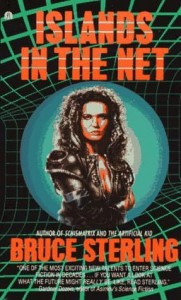 About 25 years ago, during the mid-1980s, I was a big fan of cyberpunk. I still am, but nowadays I find that most of it is crap. So I am re-reading some stuff, not only for fun but also because my book queue was empty (it isnt anymore).
About 25 years ago, during the mid-1980s, I was a big fan of cyberpunk. I still am, but nowadays I find that most of it is crap. So I am re-reading some stuff, not only for fun but also because my book queue was empty (it isnt anymore).
Anyway… during that time, more specifically in 1988, I bought and read Bruce Sterling’s “Islands in the Net”. I was into BBSs as well, knew of stuff like Bitnet, Arpanet, Fidonet, etc (those that would become the all encompassing Internet), so you can understand why I bought and loved the book.
The story is basically about “life in 2023. Information is power, and even in the peaceful post-millenial age, power corrupts. Data pirates, new-age mercenaries, high-tech shamans, and murder stalk a brutal netherworld of deregulated havens in the Global Communications Network”. You can find out more at cyberpunk.ru and at sfreader.com.
The book is actually available as a PDF file (Islands in the Net), but I think it’s worth it to quote a bit of it here. Some stuff he got wrong, some stuff he got right, and some stuff is pretty hilarious :-)…
“The Lodge did most of its business as telex, straight print sent by wire, such as guest dossiers and arrival schedules. Most of the world, even Africa, was wired for telex these days. It was cheapest and simplest, and Rizome favored it.
“Fax” was more elaborate: entire facsimiles of documents, photographed and passed down the phone lines as streams of numbers. Fax was good for graphics and still photos; the fax machine was essentially a Xerox with a phone. It was great fun to play with.
The Lodge also took plenty of traditional phone traffic: voice without image, both live and recorded. Also voice with image: videophone. Rizome favored one-way prerecorded calls because they were more efficient. There was less chance of an expensive screwup in a one-way recorded call. And recorded video could be subtitled for all of Rizome’s language groups, a major advantage for a multinational.
The Lodge could also handle teleconferencing: multiple phone calls woven together. Teleconferencing was the expensive borderland where phones blurred into television. Running a teleconference was an art worth knowing, especially in public relations. It was a cross between chairing a meeting and running a TV news show, and Laura had done it many times.
Every year of her life, Laura thought, the Net had been growing more expansive and seamless. Computers did it. Computers melted other machines, fusing them together. Television-telephone-telex. Tape recorder-VCR-laser disk. Broadcast tower linked to microwave dish linked to satellite. Phone line, cable TV, fiber-optic cords hissing out words and pictures in torrents of pure light. All netted together in a web over the world, a global nervous system, an octopus of data.”
You gotta love the references to those high-technologies like telex, fax and VCR and them being available to everyone in 2023 :-)
